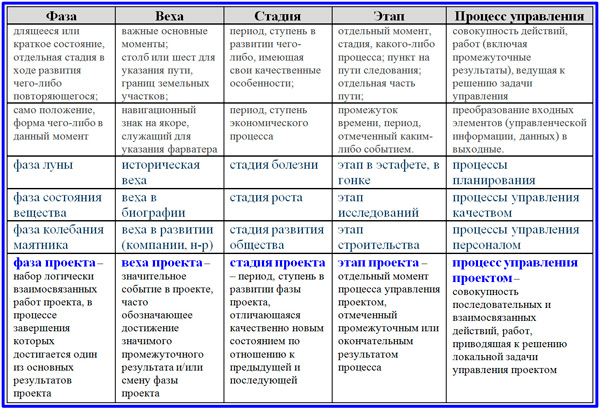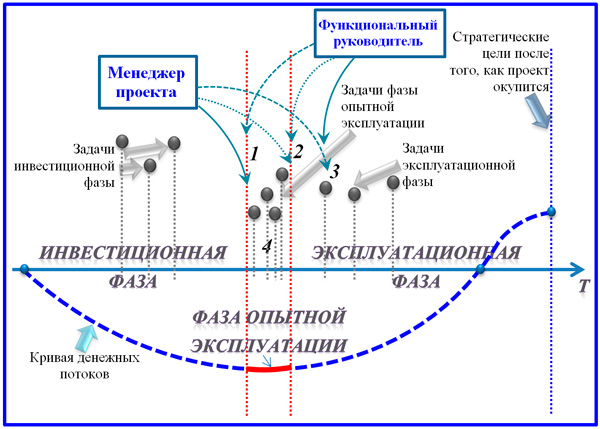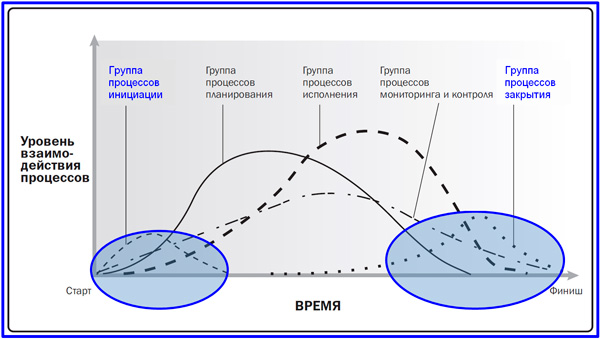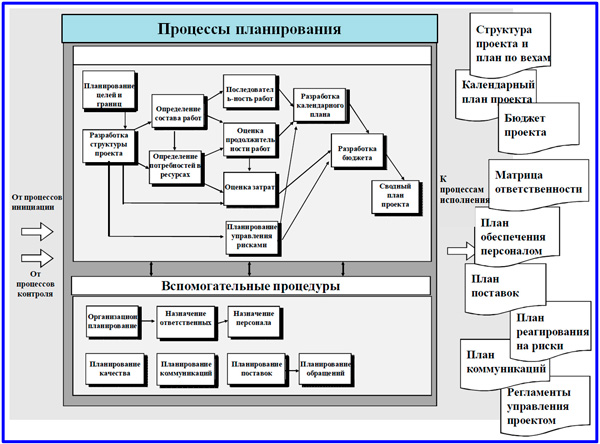Compositions of key stages of the project
Penetrating into the intricacies of intimate knowledge about project practice, a beginner PM professional or a person preparing himself to become a project manager should be free to navigate the main terminological apparatus of this kind of activity. We often hear the question of how to correctly formulate the stages of a project. Indeed, this is a difficult task. But let's first think about it, is it customary in a professional environment to operate with the concept of stages? And in what cases is this not only possible, but also necessary to do?
Definition of concepts
Those of us who have some experience in project management or at least a little theoretical background are familiar with a number of phenomena that a manager uses to represent the life cycle of an investment problem and plan its solution. At first glance, the list of these categories is simple, it includes:
- phase of the life cycle;
- milestone;
- stage;
- stage;
- management process.
The proposed concepts are often used interchangeably in practice. And if you look in the sources, it is likely that dictionaries also “sin” with circular definitions of these philosophical and applied categories. It can be noted in the scientific literature that "a phase is a stage," "a stage is a stage," and even a milestone is defined as a certain stage of the path. How to be, after all, we need to operate with an accurate perception of phenomena?
I propose to follow the procedure that we already did once with the categories of project tasks, goals and problems. Let's strengthen our common sense and look at the concepts presented above from the standpoint of ordinary empirical experience. Below is a table in the columns of which the studied categories are indicated, and in the tabular section we will place definitions, images, examples that correspond to them. Let's start with the concept of "phase". What is the essence of this concept? How can it be characterized, what are its distinctive qualities?

Composition of distinctive qualities of basic design concepts
The article on the topic is devoted to the phases of project implementation. Empirically, most of all I perceive the phase as an ongoing and expressed state of the project, for example, the development phase or the completion phase. The design task has several of these provisions, and they are always repeated, whether we like it or not. There may be several principles for dividing a project into phases, but the approach to their formulation is the same - from the standpoint of a continuing state.

A variant of dividing the project into phases from the position of transfer of responsibility from PM

A variant of dividing the project into phases from the point of view of the life cycle of the project
Above, as an illustration, an example of two schemes of the phase division of the project is given. From the point of view of the life cycle, the phases of the project are crowned with milestones - important, significant events of its implementation. On the timeline, they represent event points. The phases of the project are divided into stages - ascending periods of development, separating the qualitative states of the phase. For example, the stage of making a decision to start a project or the stage of forming a project team. A more dynamic category than phases and stages are management processes that have the following features:
- represent a sequence of works;
- related to governance, based on a regulatory framework;
- can relate to the project as a whole or to its individual phase.
Stages are also parts of management processes that include essentially homogeneous work compositions. Thus, a stage is a dynamic category that can be repeated in each phase of the project.... For example, the analysis stage. In small projects, stages, phases and stages really merge into synonyms. In major events, the stages are most pronounced in the initiation, completion, planning and execution processes.
Stages of Initiation and Completion Processes
We are examining the procedures for regular project management, taking as a basis a fairly high level of their development in the company. This is fully justified. What is the point of describing in detail the stages of each of the processes for a small-scale project? As the saying goes, "take it and do it!" Another issue is when projects include elements that are difficult to implement, and the scale of the tasks being solved is significant. Any project begins with initiation procedures, the stages of this process group are as follows.
- Formation of an initiative proposal for the project.
- Development of a business plan, feasibility study, project concept.
- Deciding on the need to complete the project.
- Appointment of a curator.
- Clarification and detailing of the goals, boundaries of the project and its results.
- Clarification of restrictions and additional requirements.
- Development of a draft version of the organizational structure of the event.
- Drawing up a draft version of the charter and issuing an order for the start of the project and the appointment of PM.
- A clean description of the project product.
- Elaboration of restrictions, requirements and risks of implementation.
- Clarifying the interests and expectations of the participants.
- Development of indicators and KFU of the project.
- Clarification of the required composition of management processes.
- Formation of a consolidated work plan.
- Coordination and approval of the final version of the charter and the enlarged plan.

Scheme of time base of project management processes. Source: PMBOK 5 Guide
In this section, we explore initiation and completion processes, which have several similarities. The main tasks of the initiation are the unambiguous definition of the project and the formulation of its goals, results, the establishment of stakeholders and their expectations. Initiation is performed at the start of the project and at the beginning of each of its phases.
The project ends sooner or later, and it is very important to correctly "park" it. In addition to closing the project upon its successful implementation, these procedures can be performed at each phase of the event, when a decision is made to terminate the work ahead of schedule. In addition to the process of closing a project or its phase, this group also includes the process associated with the procedure for learning lessons and gaining experience. Closing procedures include the following main steps.
- Transfer of results to the customer, commissioning.
- Preparation of the final report and exchange of financial and accounting documents.
- Archiving project documentation.
- Closing the project by order of the company.
Learning lessons is a very interesting and rewarding process. This includes: presentations to the project committee and to other managers in the company, analysis and documentation of conclusions on the successes, problems and errors of the project. At the final meeting, conclusions are voiced and recommendations are adopted, subject to subsequent implementation.
Steps in planning processes
Project planning processes begin from the moment the project is launched and are implemented right through to the final stages. These are multiple procedures implemented at each phase of the solution of the design problem. The objectives of these processes are: detailed content development, development of an action plan for project management, and scheduling of works. A visual step-by-step model of the planning processes is presented below.

Sequence of stages of planning processes
Let's consider the main stages of creating project plans.
- Planning project goals and boundaries... This stage is also called the definition of the content (the product as the subject of the planned event and the requirements for it). The results of this stage are the concept, feasibility study, technical specification and design and estimate documentation.
- Development. In its most complete version, the stage includes the creation of trees of goals, tasks, organizational structure, plan for milestones, start of development (WBS) and structure of consumed resources.
- Determination (clarification) of the scope of work... The purpose of this stage is to represent the entire set of operations necessary for a product to emerge, and the goals of the project implementation have been achieved. Among the tools of the stage, the WBS stands out, which is the best suited for creating such a presentation.
- Determination of the composition of consumed resources... The previous two steps set the stage for assessing the need for three types of resources: expendable, renewable and financial. Human resources, fixed assets are renewable, materials and components are consumables.
- Determination of the sequence of works... This stage allows you to build the logic of relationships between operations. The network model of the project is the key instrument of the stage.
- Estimation of duration of operations... During the stage, a parametric assessment, an assessment of the duration by analogs, an assessment of performers' proposals, an expert assessment, etc. are performed.
- Estimating the cost of work... The purpose of this stage is to clarify the cost characteristics of project tasks, taking into account the amount of resources involved, including time opportunities and financial resources.
- and planning to minimize them... This stage includes an almost complete range of risk management measures: identification, assessment, development of a strategy and tactics for regulation, and, finally, creation of a protective action plan.
- Project scheduling.
- Preparation of the project budget.
- Implementation of auxiliary planning activities... This stage includes the development of supply plans, communications and other security plans. Among other things, organizational planning is carried out, a matrix of responsibility is approved, it is planned to attract, appoint personnel and place them.
- Collecting a master plan.
Stages of the execution processes
The processes of organizing the execution of the project are exclusively in the area of PM's management competence. Setting tasks, coordinating and responding quickly, demonstrating the qualities of a leader and team inspirer - all this should be done at the stages of this group of processes. Let's imagine an example of an investment project to develop and market a new service in a company operating in the B2C market. A typical set of stages in an organization's processes would include the following.
- Project team recruitment... At this stage, it is necessary to attract specialists who own the technology of the new service. It is necessary to decide whether these people will be able to become leaders of innovations, to lead others. The main thing is that, as a result of the work, knowledge and skills are disseminated by a professional in a circle of performers. It is important to work out the involvement of all team members: the system of motivation, workload, distribution of roles and responsibilities.
- Supplier selection... This stage is associated with the need to create better market and organizational conditions for the performance of work by external contractors and suppliers. Bidding tools are often used to select suppliers based on tenders.
- Ensuring the proper quality of work... In our example, the stage consists in setting the parameters that define the concept of the quality of service delivery. Technological requirements for the service procedure, the standard of production and communication with customers are necessarily developed. These standards are included in the personnel training and audit procedures.
- Ensuring coordination of works and performers... The purpose of this stage is to ensure a clear interaction of the participants through the established priorities of tasks, agreements with functional leaders, high-quality informational support of the team.
- Debugging Stakeholder Expectation Management... It is assumed that the PM will have the value orientations and interests of the project stakeholders, and build an effective model of communication with them.
- Organization of team development... The procedure is divided into the implementation of formal management tasks and informal leadership positions: team building, strengthening the spirit of teamwork, camaraderie, etc.
- Organization of information distribution... The distribution and movement of information to addressees in the project should be organized in a compulsory, guaranteed mode.
In this article, we have analyzed the concept and content of the key stages of the main project management processes. The very nature and essence of the stage as a control object is in conflict with the design reality. In my opinion, it is more correct to speak not about stages, but about sub-processes of management processes. The reason for this is that the management procedures are stretched, sometimes not diagnosed in sequence. Under these conditions, it is difficult to single out the stage as a separate part of the project path. In any case, the logic of the PMI institute in developing a standard that relied on processes has become more obvious.
 Discounted payback period
Discounted payback period Methodological aspects of project management
Methodological aspects of project management Scrum development methodology
Scrum development methodology